Translation
Article:
Will Wang, a lawyer specializing in investment and financing, and a cryptocurrency researcher.
Chris Chu Yan, a cryptocurrency lawyer, former senior product manager at a cryptocurrency exchange, and an on-chain data researcher.
The ultimate goal of most Web3 projects is to issue their own tokens, especially during the cryptocurrency bull market phase, as token prices rise, FOMO sentiment spreads. In this pursuit of "freedom," the road is rugged, and there are always alerts from the unknown dark forest, severe ambushes by law enforcement, and even the calamity of imprisonment.
How to legally and compliantly issue tokens is the top priority for Web3 projects, but this is far from the end. Achieving decentralization for the project is the ultimate goal. Decentralization will not only bring about the benign development of the project, but also provide more compliance space for the project.
Therefore, this article will explain from the perspective of Web3 legal practitioners and a series of articles by a16z about decentralization and token issuance, why decentralization should be achieved, why decentralization will bring compliance space, and provide some compliance strategies, aiming to provide a preliminary compliance framework for Web3 project token issuance.
I. Why Achieve Decentralization?
The Internet of Web1 was once considered the greatest tool for liberation, until the platforms of Web2 gradually transformed the Internet into an authoritarian promoter, changing the relationship between network participants and platforms from cooperation to competition, and collective consensus on the network also became the single consensus of Internet platforms. The former digital utopia has become a digital prison, until the dawn of decentralized encrypted networks appeared.
Therefore, the word "decentralization" has been given too many antidotal meanings, whether it is the non-violent resistance proposed in "Cypherpunk" to resist government surveillance and censorship, or the order consensus achieved by programmers through "Code is Law," or the political advocacy of network liberalism. However, these are not the main reasons why decentralization is so important for Web3 projects.
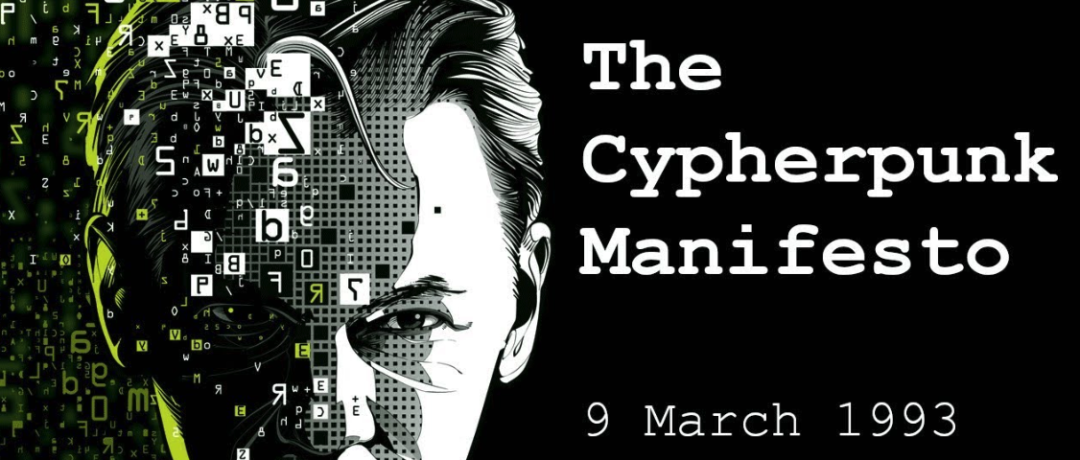 (A Cypherpunk's Manifesto)
(A Cypherpunk's Manifesto)
The encrypted network is a decentralized network built on the Internet. On the one hand, it uses consensus mechanisms such as blockchain to maintain and update the network state (collective consensus of Web3 vs. single consensus of Web2 platforms), and on the other hand, it uses cryptocurrencies to incentivize the collective participation and co-creation of network participants and other network ecosystem participants (non-profit ownership of Web1 vs. incentives and ownership of Web3 network participants).
Decentralization is a key feature of encrypted networks, which can transfer power from closed and controlled corporate organizations on Web2 Internet platforms to open and permissionless networks. Truly decentralized encrypted networks are more like public infrastructure (Public Goods) than proprietary technology, requiring strict authorized use.
This open, decentralized paradigm shift has the potential to rebuild the Internet in a way that promotes competition, safeguards freedom, protects privacy, and fair incentives, and can, under appropriate conditions, attract the collaborative efforts of global network participants, leading to exponential growth of the network ecosystem. This consensus is one of the main reasons why encrypted assets such as Bitcoin and Ethereum continue to thrive despite skepticism.
In short, decentralization means that the encrypted network returns data ownership, governance, and other rights that should belong to network participants to individuals (Ownership), enabling them to work towards a collective, common goal—the development of the network ecosystem and the utility enhancement of tokens.
II. Decentralization Brings Compliance Space
Decentralization not only enables the project to consolidate collective consensus, allowing members to collaborate globally and drive the development of the ecosystem, but also brings more space for compliance at the legal level. We will start from the perspective of SEC regulation of token issuance and compare decentralized ICOs with centralized IPOs to see how decentralization brings compliance space for Web3 projects.
2.1 Starting Point of SEC Regulation
Undoubtedly, the biggest "enemy" of the cryptocurrency industry is the U.S. Securities and Exchange Commission (SEC), which believes that almost all tokens are "securities" and should be registered under U.S. securities laws. Since the outbreak of initial coin offerings (ICOs) in 2017, tens of thousands of projects have sought to raise funds based on promises of significant technological breakthroughs (including Ethereum), but few projects have actually used the funds for implementation.
SEC attempts to apply securities laws to this simple fundraising activity, as ICOs often meet all the conditions of the Howey Test, a test used to determine whether a transaction is an investment contract: a contract, plan, or transaction in which money is invested in a common enterprise and with an expectation of profits to be derived solely from the efforts of others.
The simplest case is the primary market token financing (i.e., the issuer publicly selling tokens to investors), which would be deemed as securities.
In SEC v.s. Ripple regarding the private placement round of financing in the primary market, financing for professional investors (Institutional Sales) can also fall under SEC's securities determination: (1) investment of money; (2) in a common enterprise, i.e., Ripple uses investors' funds for its network operations, and investors' expected benefits are closely related to Ripple's development; (3) with an expectation of profits to be derived solely from the efforts of others, i.e., investors expect to gain benefits through Ripple's efforts, including interest, income, and the increased value of the investment.
In fact, Ripple also informed investors through public promotion in the market that investing in its XRP tokens could yield future profits, or that the value of XRP is linked to Ripple's efforts.
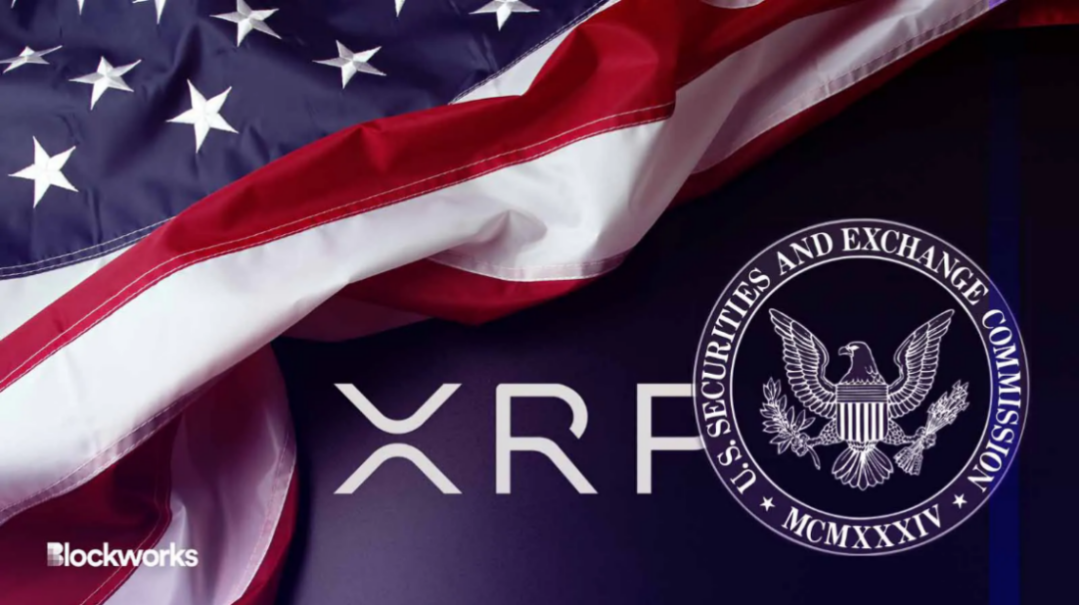
Despite this stance, the fundamental goal of both SEC and network participants is to eliminate information asymmetry and create a fair, open competitive environment.
The responsibility of Web3 network participants is to demonstrate that the methods of the encrypted network are feasible and can meet regulatory requirements, such as creating a fair competitive environment for a broader range of participants (developers, investors, users, etc.) through decentralization, using open and transparent ledgers, eliminating single central control, and reducing reliance on management teams.
2.2 Centralized IPO vs. Decentralized ICO
Let's first compare a simple centralized project IPO listing with a decentralized project ICO token issuance, and then see how the encrypted network can meet regulatory requirements.
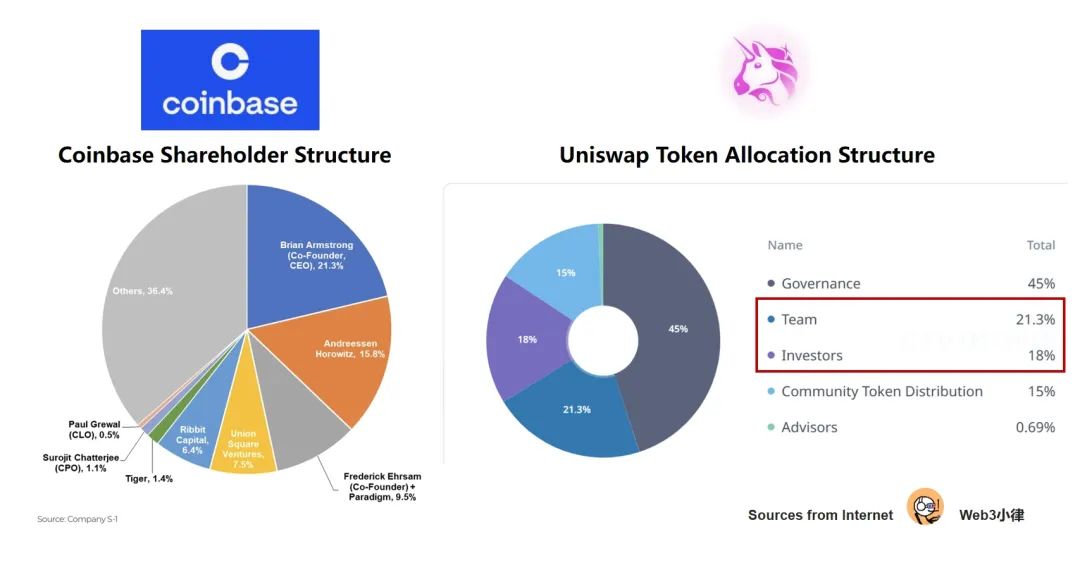
The essence of an IPO is to publicly issue a small portion of equity to raise funds, with the funds raised benefiting a small group of company shareholders.
As shown in the Coinbase IPO equity structure above, the founding team and investors hold at least 70% of the shares, and the rise and fall of the stock has no relation to users who trade on Coinbase all day. To put it more bluntly, if you trade on Coinbase all day, contribute to Coinbase's performance, what benefits does Coinbase give you in return?
The essence of ICO token issuance is to publicly issue and circulate the vast majority of tokens (in various forms such as fundraising or airdrops), allowing Web3 projects to distribute control throughout the community rather than centralizing it in the hands of the management team, thereby achieving decentralization and promoting the development of the ecosystem.
Web3 project development teams/management teams only hold a small portion of the token shares, with the vast majority of tokens being used for the construction of the project ecosystem and incentives for early contributors, DApp/protocol users, and other network participants. As shown in the Uniswap ICO, the development team and investors only retained a small portion, with the remaining 60% of the tokens used for the development and governance of the Uniswap ecosystem. In practical terms, we can earn token incentives by providing liquidity on Uniswap, participating in trading, participating in ecosystem development, and receiving grants, and so on.
Clarifying the essence of token issuance is crucial for achieving decentralization for Web3 projects; otherwise, the project will fall into the "pump and dump" logic, and long-term development will not be possible.
2.3 Decentralization Brings Compliance Space
From the perspective of decentralized token issuance, the application of the SEC Howey Test has become more challenging: (1) Investment of money—token airdrops or other means do not involve monetary investment; (2) Efforts of the management team—truly decentralized projects do not rely on the efforts of the management team; (3) Expectation of profits—secondary market investors do not necessarily need to rely on the efforts of the management team to gain returns.
At the same time, decentralization can also achieve one of the SEC's objectives—disclosure of information. When decentralized projects distribute control throughout the community rather than centralizing it in the hands of the management team, it ensures that information can reach everyone fairly.
In June 2018, SEC official William Hinman introduced the concept of "Sufficient Decentralization," stating: "If the token or the operating network behind it is sufficiently decentralized, such that investors no longer expect a person (or group) to carry out essential managerial or entrepreneurial efforts, the asset may not represent an investment contract." Based on this logic, Hinman believes that Ethereum does not fall under the category of securities sales because the current Ethereum network is sufficiently decentralized.
It is evident that decentralization is crucial for U.S. regulation.
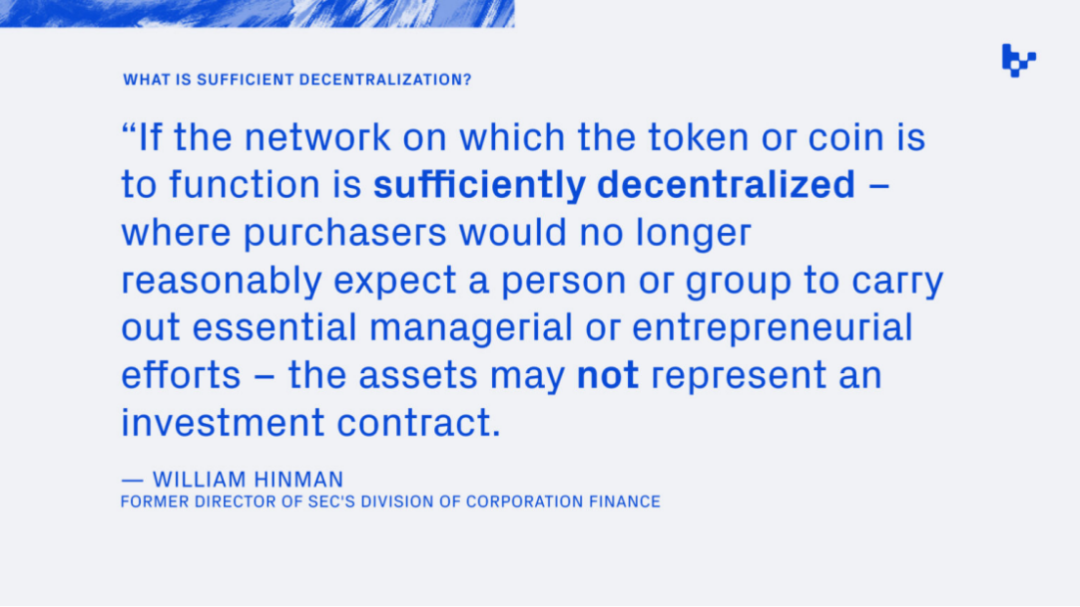 (Variant Fund, Sufficient Decentralization, A Playbook for web3 Builders and Lawyers)
(Variant Fund, Sufficient Decentralization, A Playbook for web3 Builders and Lawyers)
III. Token Issuance Compliance Guide
3.1 The Degree of Centralization Determines the Size of Project Compliance Risks
Although decentralization can bring compliance space for projects, the SEC updated its "Framework for Digital Asset Issuance" in April 2019 and continues to expand its jurisdiction over cryptocurrency assets through regulatory enforcement (Regulation by Enforcement), as seen in the regulatory enforcement against Coinbase, Binance, Ripple, Uniswap, and others.
In any case, to minimize harassment from the SEC, Web3 projects must try to operate within the guidance provided by the SEC to create more space for compliance (Mitigate Risks).
Similarly, in any jurisdiction, before conducting token issuance on exchanges (IEO), Web3 projects also need legal opinions from law firms stating that the token issuance is "non-securities" to avoid regulation under the securities laws of the relevant jurisdiction.
It is evident that the size of compliance risks that a project bears depends on its degree of decentralization. Bitcoin, which is fully decentralized, is the only encrypted asset excluded from being classified as a security by the SEC, while Ethereum is currently under scrutiny.
In this regard, Miles Jennings, the policy and legal compliance lead at a16z, clearly stated: Decentralization is the only path that projects can take to help eliminate the risks that securities laws aim to address. Decentralization is the North Star that provides the ultimate guidance for projects, and other path strategies are just temporary measures.
Of course, not all projects can achieve decentralization from the start; most Web3 projects require a process of "progressive decentralization."
3.2 Exclude Any U.S. Factors
The vast majority of projects do not have the ability to achieve complete decentralization during token issuance, so their tokens theoretically have the potential to be classified as securities by the SEC. For example, in the SEC's lawsuits against Binance and Coinbase, we saw a list of over a dozen "securities tokens." Additionally, the public issuance of tokens can also be classified as a securities sale by the SEC.
Therefore, the direct method to avoid U.S. regulation (especially by the SEC) is to exclude any U.S. factors and prevent U.S. regulators from having jurisdiction.
Similarly, this exclusion method also applies to the Chinese jurisdiction.
Therefore, in the absence of fully developed compliance capabilities, whether in the private placement stage of fundraising, the token generation event (TGE) stage, or the secondary market trading stage, Web3 projects should try to avoid U.S. factors (such as the U.S. public and U.S. investors) as much as possible.
Feasible paths include:
A. Early airdrop incentive stage: Web3 projects can geographically block/U.S. VPN block U.S. users, preventing them from participating in airdrops, token incentives, and most importantly, token public sales fundraising.
B. Private placement stage: In cases involving the private issuance of tokens to U.S. investors or employees, Web3 projects can still operate under the exemptions provided by SEC Regulation S.
C. Public issuance and listing for trading: Tokens can be issued by entities located outside the U.S., and early listing on U.S.-based cryptocurrency exchanges such as Coinbase, Gemini, and Kraken can be avoided.
In practice, most offshore foundations (such as Cayman, BVI, Singapore) become the entities for token issuance, meaning that the tokens are decentralized, and governance rights are governed by non-profit foundations, which are isolated entities without shareholders and conflicts of interest, solely focused on the development of the project ecosystem.
Fundamentally, if a project does not offer its tokens to U.S. citizens, even if it is not "sufficiently decentralized," the risk of SEC enforcement will be significantly reduced. Therefore, every effort should be made to avoid any token public sales for fundraising purposes targeting U.S. factors.
3.3 Operational Restrictions for Projects
Although some of the strategies mentioned above can address regulatory issues to a certain extent (such as excluding U.S. factors), Web3 projects, as they are born to target the global market and operate mostly online, especially need to follow certain restrictions in their daily operations, particularly when discussing the value of tokens (e.g., on Discord, Twitter, Telegram, and other social channels, as well as in text and email), to avoid falling into regulatory traps. These activities include:
- Protocol development
- Business expansion
- Marketing curation
- Intellectual property
- Governance decisions
3.3.1 Decentralization Transformation of Project Identity
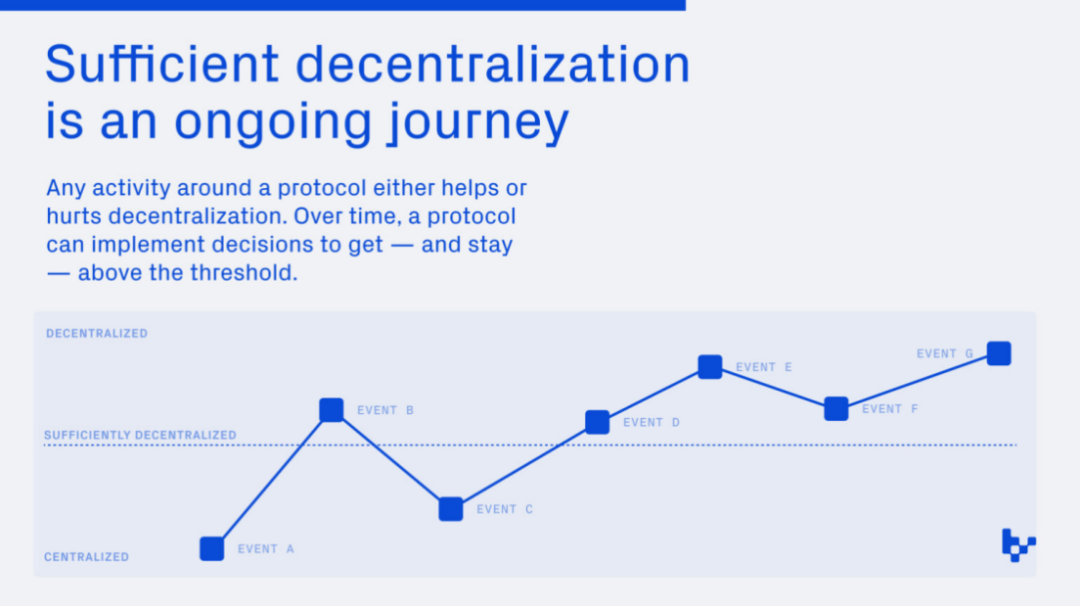 (Variant Fund, Sufficient Decentralization, A Playbook for web3 Builders and Lawyers)
(Variant Fund, Sufficient Decentralization, A Playbook for web3 Builders and Lawyers)
Before the public sale, and after the token issuance, Web3 projects should avoid several situations:
A. Before launching the public sale, discussions or references to the value of their own tokens should be avoided as much as possible. This includes potential airdrops, token distribution, or token economics. We have seen the SEC previously block Telegram's token issuance.
B. At all times, discussions about the token's price or potential appreciation expectations should be avoided, as well as treating it as an investment opportunity. This includes mentioning any expectations that could lead to token appreciation (e.g., programmatically "burning" tokens to achieve pricing targets or stability mechanisms), and making commitments to continue funding the project's development and success using private capital.
C. After the token issuance, the project enters a decentralized phase, and the founding team or management team (including founders, development companies, foundations, and DAOs) should clearly define their position.
Web3 projects should use "initial development team" instead of the previous "core development team" or "main development team," and use "core contributors/contributors" instead of individual titles from previous companies. Members of the foundation and DAO should define themselves as non-profit contributors who promote the development and growth of the protocol/DApp/DAO.
At this point, Web3 projects are prone to using centralized language, even if the project is extremely decentralized, especially when they are accustomed to speaking in the first person about achievements, milestones, and other releases. The pitfalls of this self-positioning include:
- Avoid implying ownership or control of the protocol/DApp/DAO (e.g., "As the CEO of the protocol…" "Today, we opened feature X of the protocol…").
- Avoid making commitments or guarantees about the work being done on the protocol/DApp/DAO, and avoid emphasizing the work being done as having too much importance for the ecosystem.
- Avoid emphasizing efforts to promote or further decentralize the project.
- Provide independent speaking rights for the project's DAO or foundation to avoid confusion. A better approach is to differentiate the project development company Labs from the subsequent foundation (e.g., official Twitter accounts for Ondo Finance and Ondo Foundation, Uniswap Labs and Uniswap DAO), or simply not share the name with the protocol.
- Ultimately, all communication should reflect the principle of decentralization, especially in public settings. Communication needs to be open and aimed at preventing any individual or group from having significant asymmetric information.
The transformation of identity is particularly important, and it is important to be mindful of what you say, as you are no longer the CEO with great power.
3.3.2 Public Information Channels
In addition to the matters that Web3 projects need to be mindful of in their daily operations, they should disclose the project's progress and operations to the public as much as possible, which is exactly what the SEC requires in terms of disclosure. For example, simple and practical public communication methods such as public Notion pages, Discord channels, governance proposal voting forums, and weekly summary meetings are needed.
In a decentralized encrypted network, because project code is open source, the key to the success of decentralized projects lies in execution, not in holding "confidential" information. If a project withholds "confidential information" without disclosing it, it is unfair to investors and exacerbates the security attributes of the token.
3.3.3 Token Lock-Up Period
Furthermore, Miles Jennings also mentioned the need to always extend the token lock-up period, at least one year from the date of token issuance. The lack of a one-year lock-up period was successfully used by the SEC to literally prevent Web3 projects from issuing tokens. This approach can help mitigate the aforementioned legal compliance risks, reduce the pressure of token dumping on token prices, and demonstrate confidence in the project's long-term viability.
Once decentralized, no individual or company is the spokesperson for the project. The project's ecosystem is its own, independent, and unique.
IV. Exemplars of Decentralized Projects
While it is difficult to define a standard for complete decentralization in the market, we can still be guided by observing the decentralized paths of some relatively compliant projects in Europe and the United States. Uniswap, as the most successful decentralized exchange, has a growth path that is particularly worth learning from, especially in the sensitive cryptocurrency trading business, and in the context of opaque U.S. regulation. Additionally, compliance for Fintech companies is of utmost importance.
We have outlined the compliance path of Uniswap Labs after the separation from the protocol, which provides a regulatory-friendly decentralized sample for Web3 projects. The purpose of this separation is to achieve progressive decentralization on one hand, and to gain more leeway in regulatory compliance on the other.
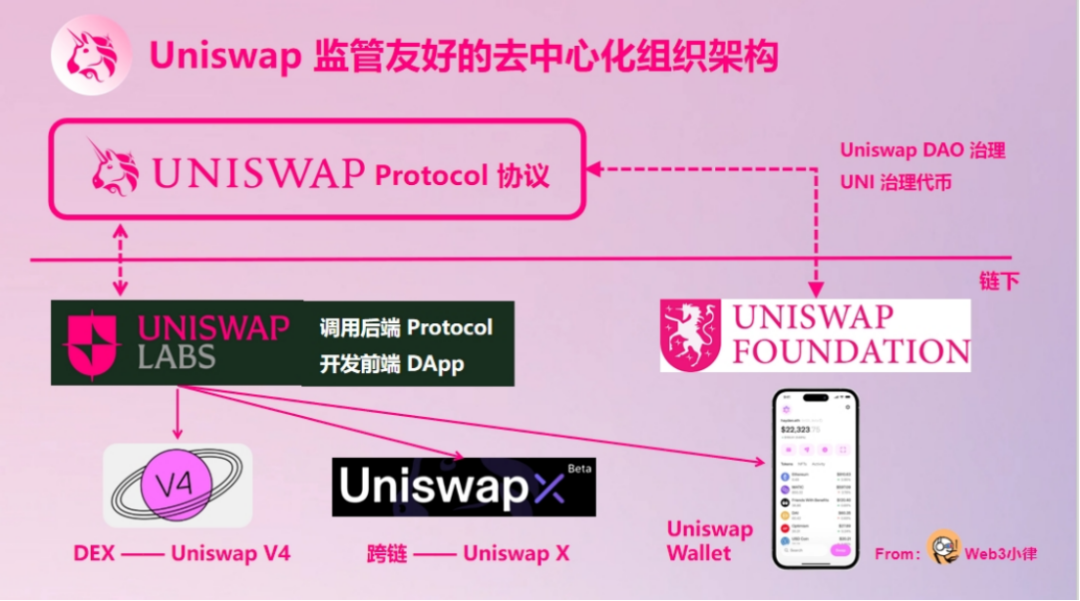
A. Decentralized Non-Security Tokens
The Uniswap protocol operates independently on the chain, governed by the Uniswap DAO, achieving decentralization, with the single-purpose token UNI serving as its governance token. This model avoids SEC's classification of securities and has favorable court rulings.
B. DAO Legal Packaging Limited Liability of Members
Uniswap DAO establishes the legal entity of Uniswap Foundation as the legal packaging of the DAO, ensuring the limited liability of DAO members on one hand, and enabling interaction with the Web2 world to expand its influence on the other.
C. Independent Operation of Labs Flexible Front-end Development
The Uniswap Labs team, which previously developed and maintained the protocol, operates as a separate legal entity and becomes the main contributor to the protocol. This not only frees the team from restrictions imposed by the protocol, but also allows them to build and maintain front-end products by calling the back-end protocol, ensuring sustainability, such as the previously initiated fee model for the Uniswap DApp.
D. Regulatory Application Rather Than Protocol
As advocated by a16z, decentralized on-chain protocols are just code and are difficult to comply with regulations, while front-end applications developed by Labs can fully comply with regulatory requirements, allowing the team and the product itself to avoid potential regulatory risks. Like any app, front-end applications can incorporate KYC/AML/CTF verification as required by regulations, delist tokens flagged by regulators at any time, and apply for licensing qualifications, among other things.
Although on April 10, 2024, Uniswap Labs received a Wells Notice from the SEC, informing them of possible regulatory enforcement actions such as lawsuits against Uniswap Labs, it is more about the nature of its encrypted trading business itself, rather than non-compliance with the decentralized legal structure.
V. Regulatory Barriers in the Chinese Jurisdiction
The token issuance compliance strategies mentioned above are a summary of the compliance experiences of some leading projects, especially those involving a relatively open jurisdiction for cryptocurrency assets like the United States. For a jurisdiction like China, which prohibits any cryptocurrency activities, token issuance inevitably comes with great risks.
In essence, the regulatory nature of the two jurisdictions is the same. Imagine being in a gray area, where a project earns shining gold through gray means, and it happens to be seen by some people who happen to "have" enforcement power. The United States values the rule of law and will use legal means to deal with you, while China's one-size-fits-all approach indicates everything.
Therefore, every effort should be made to avoid any possible reasons for enforcement.
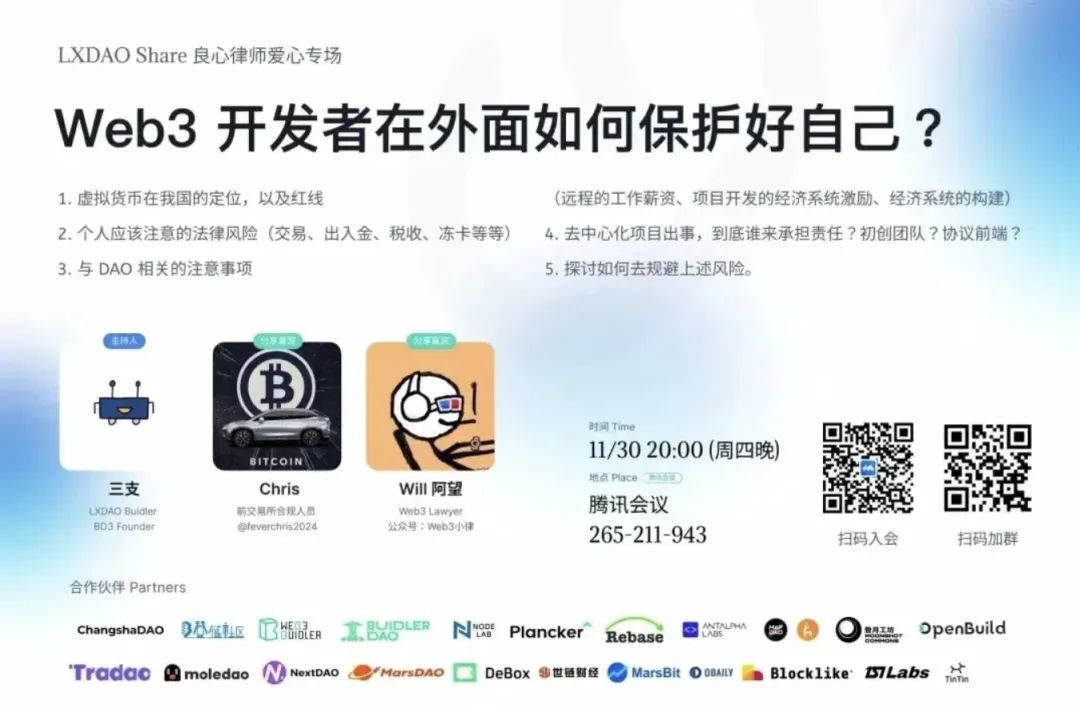
5.1 Criminal Risks in the Token Issuance Process
It is well known that decentralization is a major characteristic of the Web3 industry, but the project team behind the operation of decentralized projects and the ultimate controllers of on-chain addresses are always citizens subject to legal supervision and constraints. Therefore, project teams need to avoid crossing the red line of Chinese law as much as possible during the token issuance and fundraising process. During token fundraising, project teams often use high returns to attract users to invest, conduct project promotion through public channels such as Twitter and Telegram, and collaborate with ground promotion teams to attract unspecified groups for project promotion. This token fundraising model is highly likely to constitute the crime of illegal absorption of public deposits.
The founding team of Web3 projects has raised a huge amount of assets through token issuance in a short period of time. Due to the lack of necessary regulation and management of the project's financial situation, the disclosure of fund handling is opaque, which can easily lead to the misuse of funds by the project team for personal purposes. This includes core team members purchasing luxury cars, mansions, or using funds for personal cryptocurrency trading, ultimately leading to the squandering of funds raised and the inability to return them for ecosystem project construction, thereby constituting the crime of fundraising fraud.
In addition, as mentioned above, during the token promotion and marketing process, in order to achieve rapid user growth, it is common to collaborate with ground promotion teams and KOLs to attract users to purchase hardware devices and cloud computing power for profit. This model easily constitutes the crime of organizing and leading pyramid selling activities.
5.2 Beware of Opportunistic Law Enforcement's Harm to Web3 Projects
Currently, local governments in some remote areas are under tremendous financial pressure. In judicial practice, there is serious opportunistic law enforcement against Web3 projects. Technology companies collaborate with public security agencies to investigate and arrest key members of domestic projects, such as project executives and those holding private keys, and forcibly transfer the project tokens or other cryptocurrencies held by the individuals to addresses controlled by the public security agencies for disposal and realization.
Normally, confiscated income should be turned over to the national treasury, but in judicial practice, a few local governments use confiscated income as part or all of the case handling expenses, returning it to the law enforcement agencies. This allows the collaborating technology companies to receive a technical service fee.
This poses a threat to the business model of Web3 projects.
In the aforementioned law enforcement activities, the investigation of core project members by regulatory authorities on the grounds of involvement in a case will inevitably cause panic and a lack of security among community members. The disposal and realization of project tokens in the secondary market by law enforcement agencies will also cause drastic fluctuations in the token price. After the entire project is investigated by law enforcement agencies, regardless of whether the final conclusion involves suspicion of illegal activities, the project will find it difficult to continue operating in the future. Ultimately, the community developers, loyal users, and investors will bear the brunt of all this.
Therefore, for Web3 projects, in the face of the harm that opportunistic law enforcement may cause to investors and ecosystem participants, it is necessary to arrange for core members of the project such as product and technical personnel, as well as multi-signatory managers of project addresses, to work overseas. Implement multi-signature management for project financial addresses to avoid single-point risks and take responsibility for the security of users' assets.
VI. Conclusion
The above framework provides a preliminary compliance approach for token issuance for Web3 projects. Of course, different projects will have different compliance points that need to be added, such as data compliance requirements for DePIN and DeAI projects, financial compliance requirements for RWA and payment projects, and so on. Before the project is implemented, please consult your own lawyer. Not Your Lawyer, Do Your Own Research.
This framework aims to help Web3 projects explore token economics, ecosystem development, and promote project decentralization with more confidence, without having to bear the risks associated with owning tokens.
Of course, not every project will be suitable for Web3 project decentralization, and achieving decentralization takes time. Compliance also requires a corresponding cost, and project teams must carefully plan for decentralized operations.
Reference:
[1] Why Decentralization Matters
https://a16zcrypto.com/posts/article/why-decentralization-matters/
[2] 5 rules for token launches
https://a16zcrypto.com/posts/article/5-rules-for-token-launches/
[3] How to navigate token launch risks
https://a16zcrypto.com/posts/article/navigating-token-launch-risks/
[4] How to launch a token: Operational guidelines from creation to custody
https://a16zcrypto.com/posts/article/token-launch-operational-guidelines/
[5] Progressive decentralization: a high-level framework
https://a16zcrypto.com/posts/article/progressive-decentralization-a-high-level-framework/
[6] Sufficient Decentralization, A Playbook for web3 Builders and Lawyers
https://variant.fund/articles/sufficient-decentralization/
免责声明:本文章仅代表作者个人观点,不代表本平台的立场和观点。本文章仅供信息分享,不构成对任何人的任何投资建议。用户与作者之间的任何争议,与本平台无关。如网页中刊载的文章或图片涉及侵权,请提供相关的权利证明和身份证明发送邮件到support@aicoin.com,本平台相关工作人员将会进行核查。




